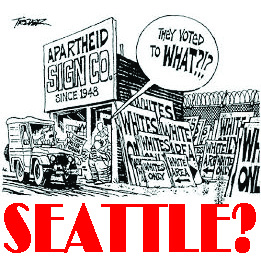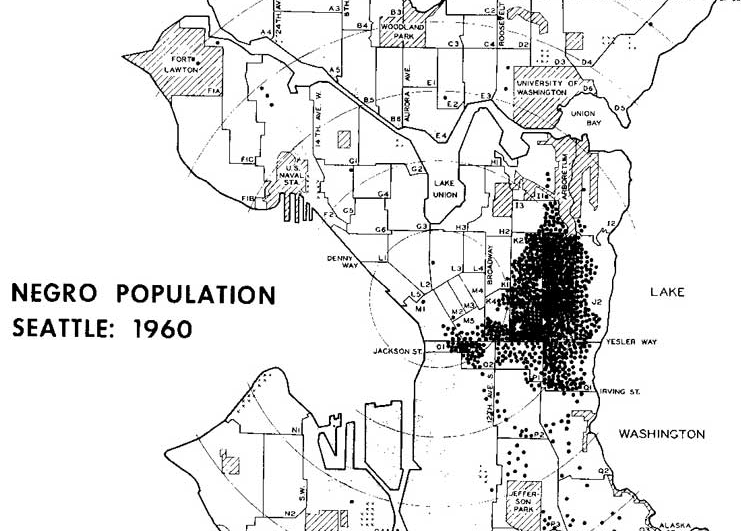 A couple of days ago on TA , Ed Clark responded to the Seattle Housing Affordability and Livability Agenda (HALA) charge that Seattle’s zoning is rooted in and responsible for racial segregation in Seattle.
A couple of days ago on TA , Ed Clark responded to the Seattle Housing Affordability and Livability Agenda (HALA) charge that Seattle’s zoning is rooted in and responsible for racial segregation in Seattle.

PUBLICOIA: Josh Kelety: Read an excellent summary of the arguments supporting the claim that Seattle is a racially sgregated city .. by intent. The bulk of the argument comes from a study at the University of Washington in 2006 called the “Seattle Civil Rights & Labor History Project.” The study led by Professor James Gregory claims that even though Seattle did not have de jure segregation, local covenants and a focus on single family housing achieved the same effect.
In this case the UW study hypothesized that Seattle was segregated because of intentional zoning and real estate contract provisions. However, what the report showed was evidence that such zoning (mainly single family housing) and racial covenants in deeds did exist and correlated with racial patterns. So, even noble Seattle .. the home of McDermott and the Wobblies, is not free of bigotry.
 The facts, however, do not prove that bigotry caused or causes ethnic separation in Seattle today Look at this figure from the study. Why is it any more surprising that African Americans (then called “Negros” lived in the Central Area than it would be if someone asked why Norwegian Americans lived in Ballard, Sephardic Americans lived in Seward Park, or all of the members of the Seattle Broadmoor Country Club were wealthy? When my wife and I moved to Seattle 4o years ago, Broadmoor did have a racist (and anti Catholic and anti Semitic covenant) The “restricted” sign at the gate was very clear to us. But the idea that restricted signs or real estate covenants explains the ethnicity of Ballard, Seward Park, Chinatown or the CD is simply wrong. Worse, conflating charges of racism with an attack on single family housing is the kind of racial politics no better when it comes from the left than when it comes from the right.
The facts, however, do not prove that bigotry caused or causes ethnic separation in Seattle today Look at this figure from the study. Why is it any more surprising that African Americans (then called “Negros” lived in the Central Area than it would be if someone asked why Norwegian Americans lived in Ballard, Sephardic Americans lived in Seward Park, or all of the members of the Seattle Broadmoor Country Club were wealthy? When my wife and I moved to Seattle 4o years ago, Broadmoor did have a racist (and anti Catholic and anti Semitic covenant) The “restricted” sign at the gate was very clear to us. But the idea that restricted signs or real estate covenants explains the ethnicity of Ballard, Seward Park, Chinatown or the CD is simply wrong. Worse, conflating charges of racism with an attack on single family housing is the kind of racial politics no better when it comes from the left than when it comes from the right.  Demagoguery aside, aside the fact is that Seattle is undergoing a form of apartheid. The central district will be under 10% African American by 2020. The idea, espoused by a proud progressive like Licata or by the self proclaimed Trotskyite Sawant, that Seattle can solve racial segregation by restricting new development makes no sense.
Demagoguery aside, aside the fact is that Seattle is undergoing a form of apartheid. The central district will be under 10% African American by 2020. The idea, espoused by a proud progressive like Licata or by the self proclaimed Trotskyite Sawant, that Seattle can solve racial segregation by restricting new development makes no sense.

Read another point of view by Erica Barnett with an excellent focus on the Gregory Report but also an attack on wealthy enclaves.
This nativist argument, coming from an Indian Immigrant, is oddly reminiscent of something the Donald would say! The unwritten subtheme is that Sawant and Licata have policies opposed to the evil policies of  Tea Party conservatives who would defend single-family neighborhoods as a sacred refuge for America’s Judeo Christian heritage. The red shirted crowd of Sawant followers paint their rules … whether rent control or a 25% levy on new housing .. as light brown, the color of racial diversity. The say they intend to crack open the gates of “exclusive” (HALA’s word) communities to “people of color” and the oppressed lower classes. Ironically, as owners of single family homes, Sawant and Licata are themselves beneficiaries of this chauvinistic, not in my back yard policy. Kshama Sawant bought her house in the once Black neighborhood of Leschi a year ago for $350,000. Her house is now worth $500,000.
Tea Party conservatives who would defend single-family neighborhoods as a sacred refuge for America’s Judeo Christian heritage. The red shirted crowd of Sawant followers paint their rules … whether rent control or a 25% levy on new housing .. as light brown, the color of racial diversity. The say they intend to crack open the gates of “exclusive” (HALA’s word) communities to “people of color” and the oppressed lower classes. Ironically, as owners of single family homes, Sawant and Licata are themselves beneficiaries of this chauvinistic, not in my back yard policy. Kshama Sawant bought her house in the once Black neighborhood of Leschi a year ago for $350,000. Her house is now worth $500,000.
HALA and the UW report were well intended but the redlining, restrictive covenants, and unwritten policies of real estate agents in the last century are not the reason ethnic groups today choose to create neighborhoods. Nor is the reality of differences in wealth that create places like Laurelhurst and White Center a very good reason to attack peoples’ rights to create or maintain ethnic neighborhoods.
An arguement made explicit by Erica Barnett might be better put as an argument over class. Erica accepts the mantra that wealth ought not to be a basis for community. Should  we endeavor to break down the financial divide between Seattle neighborhoods by introducing more lower and low income housing into Magnolia? As a moderate income Seattleite I would love to be able to see my kids able to buy a condo in Broadmoor or Magnolia but suspect the plans in HALA are not going to effect that sort of change. Why wouldn’t efforts at class integration in housing lead to the same sort of bad consequences Seattle Schools saw as a result of our forced busing scheme? Remembering the effects of White Flight elsewhere, it is at least worth wondering if a homeless duplex in my neighborhood might not postpone the time when houses here start at $2 million dollars. Could “Class Flight” be an answer to rising real estate prices?
we endeavor to break down the financial divide between Seattle neighborhoods by introducing more lower and low income housing into Magnolia? As a moderate income Seattleite I would love to be able to see my kids able to buy a condo in Broadmoor or Magnolia but suspect the plans in HALA are not going to effect that sort of change. Why wouldn’t efforts at class integration in housing lead to the same sort of bad consequences Seattle Schools saw as a result of our forced busing scheme? Remembering the effects of White Flight elsewhere, it is at least worth wondering if a homeless duplex in my neighborhood might not postpone the time when houses here start at $2 million dollars. Could “Class Flight” be an answer to rising real estate prices?
The changes in Seattle today are because of newbies, new people who want to live in Seattle, not because of past policies. Last week my wife and I happened to be in the “new Seattle” .. affordable Ballard and Fremont. We were pleasantly struck by the brown, mixed skin tones of the folks on the street. Lots of “whites” but also many folks who were brown or black. My question, however is whether these skin colors actually reflect ethnic diversity? What we saw was great, but not at all the kind of flavor Seattle will lose if we attack people’s rights to create communities that share and celebrate ethnic heritage.